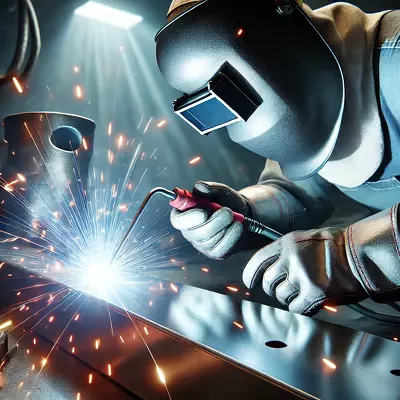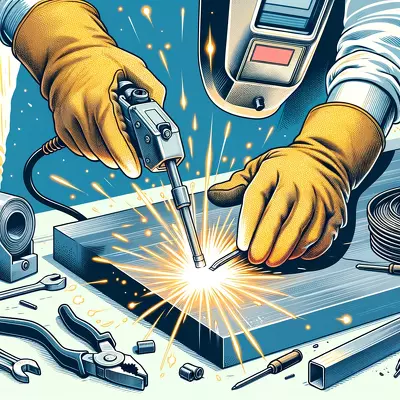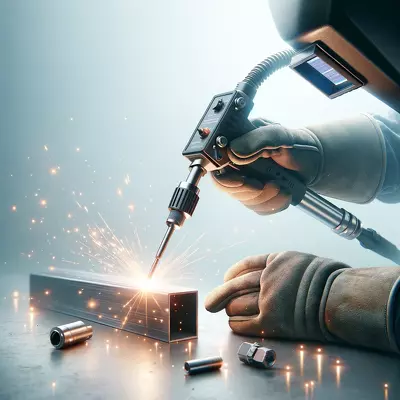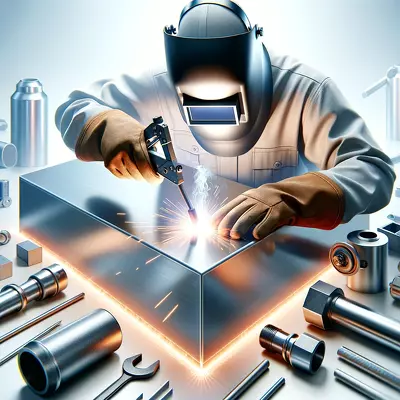Gas vs. No Gas MIG Welding: A Complete Guide for Welders Seeking Precision
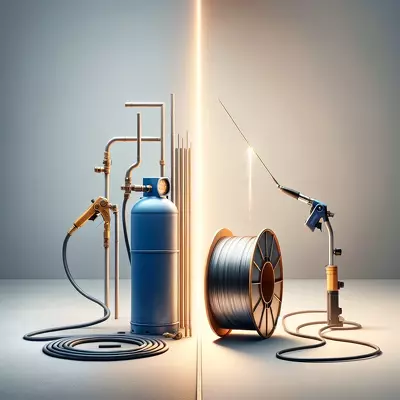
Metal Inert Gas (MIG) welding, a cornerstone of manufacturing and repair, presents a pivotal choice between using gas shielding or opting for a gasless process. This decision impacts weld quality, efficiency, and applicability across different materials and environments. Understanding the nuances of each method equips welders with the knowledge to select the most appropriate technique for their specific project requirements, balancing factors such as cost, ease of use, and the physical characteristics of the finished weld.
I. Overview of MIG Welding
A. Definition and Basics
Metal Inert Gas (MIG) welding, developed in the mid-20th century, has become a fundamental technique in fabrication and repair. It involves creating an electric arc between a consumable wire electrode and the metal workpieces. This arc heats the metals to their melting point, allowing them to fuse as they cool. A key feature of MIG welding is its adaptability to either gas-shielded or gasless operations, each catering to specific needs and environments.
B. Importance in Manufacturing and Repair
The versatility and efficiency of MIG welding have cemented its importance across various industries, including automotive, construction, and aerospace. Its ability to produce high-quality welds quickly and with relative ease makes it invaluable for both production line manufacturing and intricate repair work. The technique’s adaptability to different metals and thicknesses further broadens its applicability, ensuring its status as a staple in workshops and factories around the globe.
II. Gas Shielded MIG Welding
A. Process and Mechanism
Gas-shielded MIG welding, also known as Gas Metal Arc Welding (GMAW), relies on an external shielding gas to protect the weld pool from atmospheric contamination. This gas, typically a mix of argon and carbon dioxide, forms a protective barrier around the welding area, preventing oxidation and ensuring a clean, strong weld. The process is highly controlled, allowing for precision and consistency in welds.
B. Advantages
The primary advantage of gas-shielded MIG welding is its ability to produce clean, high-quality welds free from porosity and contamination. The shielding gas ensures a stable arc and minimal spatter, resulting in smoother finishes and stronger joins. This method is particularly effective for thin materials and metals sensitive to oxidation, such as stainless steel and aluminum.
C. Common Applications
Due to its precision and cleanliness, gas-shielded MIG welding is widely used in industries where weld integrity is paramount. Automotive manufacturing, where consistent, high-strength welds are necessary for safety, relies heavily on this method. Similarly, the construction of pressure vessels and pipelines benefits from the controlled environment gas shielding provides, ensuring durability and compliance with strict standards.
III. Gasless MIG Welding
A. Process and Mechanism
Gasless MIG welding, or Flux-Cored Arc Welding (FCAW), utilizes a special wire with a flux core instead of an external shielding gas. When heated, the flux creates a gas shield and a slag layer, protecting the weld pool from contamination. This method is more adaptable to outdoor conditions, where wind might disperse a gas shield, making it ideal for field repairs and construction.
B. Advantages
The most significant advantage of gasless MIG welding is its flexibility and portability. It eliminates the need for gas tanks, making it suitable for on-site repairs and construction. It performs well on thicker materials and is more forgiving of surface contaminants, reducing the need for extensive pre-weld cleaning. The flux core wire also aids in penetrating thicker materials, making it a robust choice for heavy-duty applications.
C. Common Applications
Gasless MIG welding is commonly employed in construction projects, especially in outdoor environments where the use of shielding gas is impractical. It is also favored for repair work in agricultural and mining equipment, where the conditions are less controlled, and the ability to weld effectively without a clean surface is a significant advantage.
IV. Comparing Gas Shielded and Gasless MIG Welding
A. Quality of Weld
When comparing the two methods, gas-shielded welding typically produces cleaner, more aesthetically pleasing welds with less spatter. In contrast, gasless welding is more about functionality, offering good penetration and strength but with a rougher finish due to the slag that must be chipped away post-weld.
B. Cost Implications
The initial setup for gas-shielded welding can be more expensive due to the need for gas tanks and regulators. However, the consumables for gasless welding, particularly flux-cored wire, tend to be costlier in the long run. The choice between the two may come down to the specific project requirements and long-term use.
C. Suitability for Different Environments
Gas-shielded MIG welding excels in controlled environments where the quality and precision of the weld are crucial. On the other hand, gasless MIG welding is more suited to outdoor applications or where conditions are less ideal, offering robust performance against the elements.
D. Ease of Use
For beginners, gasless MIG welding can be more forgiving, with less concern over setting up and maintaining a gas shield. However, mastering gas-shielded welding can offer greater control and flexibility in a wider range of applications, rewarding those who invest the time to learn its nuances.
V. Making the Choice: Factors to Consider
A. Material Type
The material to be welded plays a significant role in choosing between gas-shielded and gasless welding. Gas-shielded welding is typically better for thin or sensitive materials, whereas gasless welding is better suited for thicker, more robust materials.
B. Project Requirements
Consider the project’s end requirements, including the strength needed in the weld, the importance of aesthetics, and whether the weld will be subject to critical stress or inspection standards.
C. Environmental Conditions
The welding environment can dictate the feasible choice. Outdoor or windy conditions may necessitate the use of gasless welding, whereas indoor or controlled environments can benefit from the clean finishes of gas-shielded welding.
D. Personal or Organizational Preferences
Finally, personal experience, available equipment, and organizational policies influence the choice. Some welders may prefer the convenience and portability of gasless welding, while others prioritize the clean, high-quality results of gas-shielded welding.
VI. FAQs
Q: What is the primary difference between gas-shielded and gasless MIG welding?
A: The primary difference lies in the use of a shielding gas. Gas shielded MIG welding uses an external gas supply to protect the weld pool from contamination, while gasless MIG welding relies on a flux core within the wire to produce a protective shield around the weld.
Q: Can gasless MIG welding be used on all types of metals?
A: Gasless MIG welding is most effective on thicker metals and is less suitable for thin metals or those that are highly reactive to oxygen, such as aluminum.
Q: Is gas shielded MIG welding more expensive than gasless?
A: Initially, gas shielded MIG welding may have higher costs due to the need for a gas supply and regulators, but the cost of consumables for gasless welding can be higher over time.
Q: Can I switch between gas-shielded and gasless welding with the same equipment?
A: Yes, most modern MIG welders allow for both gas-shielded and gasless welding. However, you will need to change the welding wire and possibly the contact tip and polarity.
Q: Which MIG welding method is better for outdoor welding?
A: Gasless MIG welding is generally better for outdoor conditions as it does not rely on a shielding gas that the wind can disperse.
Q: Do both welding methods require the same level of skill?
A: Both methods require skill and practice to master, but gasless MIG welding is often considered more beginner-friendly due to its simpler setup and forgiving nature regarding surface contamination.
Q: How do I decide which MIG welding method to use for my project?
A: The decision should be based on several factors, including the type of metal, thickness, welding environment, and desired weld quality. Consider the advantages and limitations of each method in relation to your specific project needs.
VII. Conclusion
A. Summary of Key Points
The article delves into the specifics of gas-shielded and gasless MIG welding, outlining each method’s processes, advantages, and common applications. It emphasizes the importance of choosing the appropriate welding technique based on material type, project requirements, environmental conditions, and personal preferences to ensure optimal welding outcomes.
B. Final Recommendations
In selecting between gas-shielded and gasless MIG welding, it’s crucial to weigh the benefits of each against the project’s demands. By understanding the distinctions and applications of both methods, welders can make informed decisions that lead to high-quality, efficient, and cost-effective welding solutions.
VIII. Suggested Readings
Exploring the vast world of MIG welding further can deepen understanding and skill. Here are several recommended titles that offer insights ranging from beginner basics to advanced techniques:
- “Learn to Weld: Beginning MIG Welding and Metal Fabrication Basics” by Stephen Christena. This book provides a comprehensive introduction to MIG welding, offering step-by-step guidance and practical projects.
- “Welder’s Handbook: A Guide to Plasma Cutting, Oxyacetylene, ARC, MIG, and TIG Welding” by Richard Finch. A valuable resource that covers a wide range of welding methods, including detailed information on MIG welding.
- “Welding For Dummies” by Steven Robert Farnsworth. An accessible guide for those new to welding, including tips and techniques for successful MIG welding.
- “The Welding Business Owner’s Hand Book: How to Start, Establish and Grow a Welding or Manufacturing Business” by David Zielinski. Although broader in scope, this book offers invaluable advice for those looking to apply MIG welding within a business context.
- “Modern Welding” by Andrew D. Althouse, Carl H. Turnquist, William A. Bowditch, Kevin E. Bowditch, and Mark A. Bowditch. A textbook offering a thorough exploration of welding technologies, including MIG welding, suitable for both students and professionals.
These suggested readings provide a wealth of knowledge for anyone looking to expand their understanding of MIG welding. From mastering the basics to exploring business applications, these books offer valuable insights for welders at all levels.

